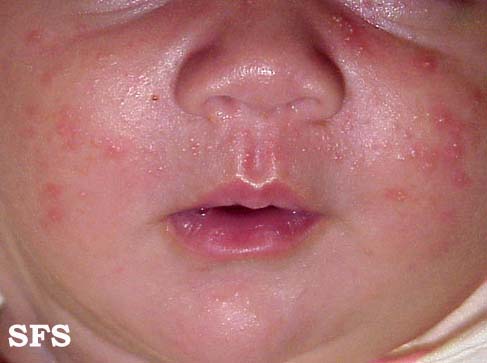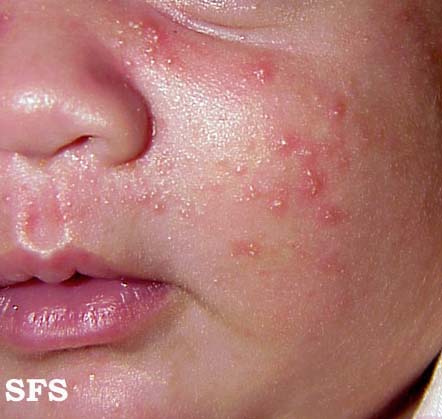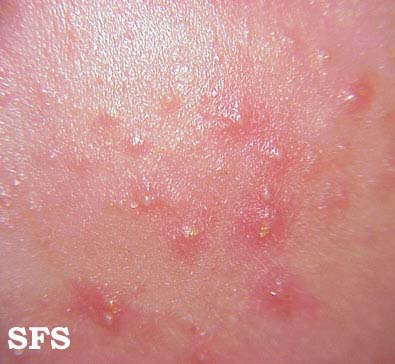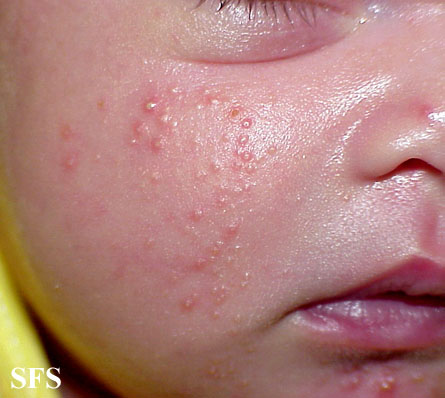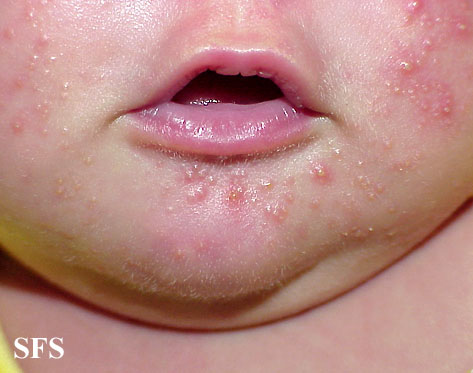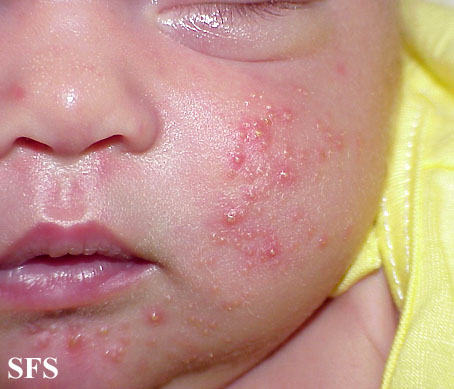Neonatal acne: Difference between revisions
No edit summary |
|||
| Line 12: | Line 12: | ||
The main cause of this condition is not known, but it could be due to the increased sensitivity of the infant's [[sebaceous glands]] to maternal hormones during pregnancy which also leads to a variety of skin conditions in the newborn.Typically, it peaks at around 2 months and rarely needs treatment. Sometimes gels or ointments are given. | The main cause of this condition is not known, but it could be due to the increased sensitivity of the infant's [[sebaceous glands]] to maternal hormones during pregnancy which also leads to a variety of skin conditions in the newborn.Typically, it peaks at around 2 months and rarely needs treatment. Sometimes gels or ointments are given. | ||
== | ==Physical Examination== | ||
===Skin=== | |||
<gallery> | <gallery> | ||
Revision as of 20:54, 9 July 2014
|
WikiDoc Resources for Neonatal acne |
|
Articles |
|---|
|
Most recent articles on Neonatal acne Most cited articles on Neonatal acne |
|
Media |
|
Powerpoint slides on Neonatal acne |
|
Evidence Based Medicine |
|
Clinical Trials |
|
Ongoing Trials on Neonatal acne at Clinical Trials.gov Trial results on Neonatal acne Clinical Trials on Neonatal acne at Google
|
|
Guidelines / Policies / Govt |
|
US National Guidelines Clearinghouse on Neonatal acne NICE Guidance on Neonatal acne
|
|
Books |
|
News |
|
Commentary |
|
Definitions |
|
Patient Resources / Community |
|
Patient resources on Neonatal acne Discussion groups on Neonatal acne Patient Handouts on Neonatal acne Directions to Hospitals Treating Neonatal acne Risk calculators and risk factors for Neonatal acne
|
|
Healthcare Provider Resources |
|
Causes & Risk Factors for Neonatal acne |
|
Continuing Medical Education (CME) |
|
International |
|
|
|
Business |
|
Experimental / Informatics |
Editor-In-Chief: C. Michael Gibson, M.S., M.D. [1]; Associate Editor(s)-in-Chief: Jesus Rosario Hernandez, M.D. [2].
Synonyms and keywords: Acne neonatorum; infantile acne; acne infantum.
Overview
Neonatal acne (also known as "Acne infantum," "Acne neonatorum",[1] and "Neonatal cephalic pustulosis"[2] (not to be confused with "Benign cephalic histiocytosis")) is an acneiform eruption that occurs in newborns or infants, and is often seen on the nose and adjacent portions of the cheeks.[3]
The main cause of this condition is not known, but it could be due to the increased sensitivity of the infant's sebaceous glands to maternal hormones during pregnancy which also leads to a variety of skin conditions in the newborn.Typically, it peaks at around 2 months and rarely needs treatment. Sometimes gels or ointments are given.
Physical Examination
Skin
-
Acne neonatorum.
Adapted from [http://www.atlasdermatologico.com.br/disease.jsf?diseaseId=5 -
Acne neonatorum.
Adapted from [http://www.atlasdermatologico.com.br/disease.jsf?diseaseId=5 -
Acne neonatorum.
Adapted from [http://www.atlasdermatologico.com.br/disease.jsf?diseaseId=5 -
Acne neonatorum.
Adapted from [http://www.atlasdermatologico.com.br/disease.jsf?diseaseId=5 -
Acne neonatorum.
Adapted from [http://www.atlasdermatologico.com.br/disease.jsf?diseaseId=5 -
Acne neonatorum.
Adapted from [http://www.atlasdermatologico.com.br/disease.jsf?diseaseId=5
References
- ↑ Holm EA, Jemec GB (December 2000). "[Acne neonatorum/acne infantum]". Ugeskr. Laeg. (in Danish). 162 (50): 6856–7. PMID 11187144.
- ↑ Rapini, Ronald P.; Bolognia, Jean L.; Jorizzo, Joseph L. (2007). Dermatology: 2-Volume Set. St. Louis: Mosby. ISBN 1-4160-2999-0.Template:Pn
- ↑ Freedberg, Irwin M.; Eisen, Arthur Z.; Wolff, Klauss; Austen, K. Frank; Goldsmith, Lowell A.; Katz, Stephen, eds. (2003). Fitzpatrick's Dermatology in General Medicine (6th ed.). McGraw-Hill. p. 648. ISBN 978-0-07-138076-8.
